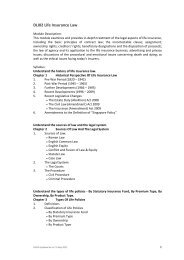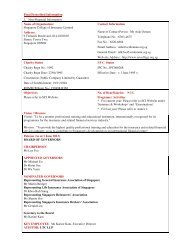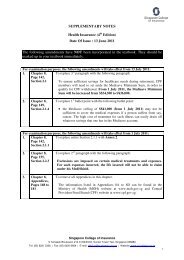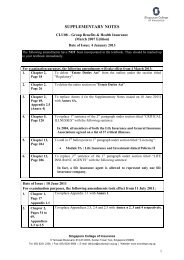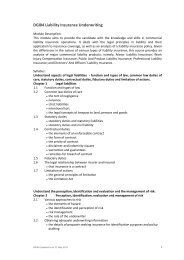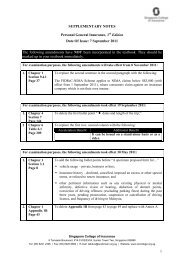DGI02 Insurance Company Operations - Singapore College of ...
DGI02 Insurance Company Operations - Singapore College of ...
DGI02 Insurance Company Operations - Singapore College of ...
You also want an ePaper? Increase the reach of your titles
YUMPU automatically turns print PDFs into web optimized ePapers that Google loves.
<strong>DGI02</strong> <strong>Insurance</strong> <strong>Company</strong> <strong>Operations</strong><br />
Module Description:<br />
This modules aims to provide the candidate with the knowledge <strong>of</strong> the types <strong>of</strong> business<br />
organisations and their functions; the operations <strong>of</strong> insurance companies, such as<br />
underwriting and claims, as well as business organisations in general, such as management<br />
and human resources. It also aims to build an understanding <strong>of</strong> financial statements for<br />
insurance pr<strong>of</strong>essionals as well as the interpretation <strong>of</strong> financial statements and budgeting<br />
principles.<br />
Syllabus:<br />
Understand business organisations in relation to insurance.<br />
Chapter 1 Business organisations<br />
1.1 Concepts in business<br />
1.2. General business trends<br />
the key global trends affecting businesses and their impact<br />
the key stakeholders involved in businesses<br />
the resources used in the production <strong>of</strong> goods and services<br />
the common business functions found in organisations<br />
the different types <strong>of</strong> business outputs<br />
how external factors affect businesses<br />
the importance <strong>of</strong> customers<br />
the concept <strong>of</strong> business clusters and their potential to affect competition<br />
business ownership and control<br />
the ways that businesses get involved in the community<br />
1.3 Objectives <strong>of</strong> business organisations<br />
the main objectives <strong>of</strong> business organisations<br />
the basic model <strong>of</strong> the business enterprise – the theory <strong>of</strong> the firm<br />
1.4 Forms <strong>of</strong> business organisations<br />
the main features <strong>of</strong> the following forms <strong>of</strong> business ownership:<br />
- sole proprietorships<br />
- partnerships<br />
- limited liability partnerships<br />
- companies<br />
- co‐operatives<br />
1.5 Financing the business<br />
why businesses need financing<br />
the common financing options available to businesses<br />
Understand business organisation and functions in relation to insurance.<br />
Chapter 2 Business organisation and functions<br />
2.1 Operational structures<br />
ways <strong>of</strong> organising operational structures, including its advantages and<br />
disadvantages:<br />
- function<br />
- product lines<br />
- area / region<br />
- customer type<br />
- holding company<br />
- matrix<br />
<strong>DGI02</strong>‐Updated as at 11 May 2011 1
the structure <strong>of</strong> a holding company<br />
2.2 Bureaucracy – the underlying concept<br />
the underlying principles relating to bureaucracy<br />
some recent developments and thinking relating to organisational structures<br />
the different managerial roles in an organisation<br />
the concept <strong>of</strong> power in organisations and the different sources <strong>of</strong> power<br />
2.3 Organisational culture<br />
the different types <strong>of</strong> organizational cultures<br />
the implications <strong>of</strong> organisation culture on business<br />
Understand the management <strong>of</strong> insurance businesses.<br />
Chapter 3 Management<br />
3.1 Board <strong>of</strong> Directors<br />
the roles <strong>of</strong> the Board <strong>of</strong> Directors and how they relate to the functions <strong>of</strong> the<br />
business<br />
the advantages <strong>of</strong> having a Strategic Board<br />
the roles <strong>of</strong> the key Board Committees<br />
3.2 Management<br />
the roles and responsibilities <strong>of</strong> managers and how these can improve business<br />
results<br />
the key challenges facing managers in business<br />
the roles <strong>of</strong> managers to the three levels <strong>of</strong> management<br />
3.3 Planning<br />
the importance <strong>of</strong> planning in the management <strong>of</strong> business<br />
the fundamental elements <strong>of</strong> business plans<br />
3.4 Decision‐making<br />
the main types <strong>of</strong> decision‐making in business<br />
the decision making process<br />
3.5 Management information<br />
the role <strong>of</strong> information management in organisations<br />
data and information<br />
the common information technologies used to support businesses<br />
3.6 Knowledge management<br />
what knowledge management is and how it may be used to improve business<br />
performance<br />
3.7 Leadership styles<br />
the differences between management and leadership<br />
the different leadership styles<br />
the advantages and disadvantages <strong>of</strong> each style in given situations<br />
the various types <strong>of</strong> models used in identifying effective leadership<br />
3.8 Roles and responsibilities <strong>of</strong> non‐managerial staff<br />
the key roles and responsibilities <strong>of</strong> non‐managerial staff<br />
where the roles <strong>of</strong> non‐managerial staff fit into organisations<br />
Understand the human resource management functions within insurance organizations.<br />
Chapter 4 Human resource management<br />
4.1 Scope <strong>of</strong> human resource management<br />
the link between human resources and business strategy<br />
the fundamental processes in human resources management<br />
<strong>DGI02</strong>‐Updated as at 11 May 2011 2
4.2 Employee‐employer relationship<br />
the importance <strong>of</strong> good relationships between employer and employee<br />
the importance <strong>of</strong> trust in managing the employee‐employer relationship<br />
4.3 Motivation and staff morale<br />
what employee motivation is<br />
the implications <strong>of</strong> motivation on employee performance and satisfaction<br />
the theories relating to motivation:<br />
- Maslow’s Hierarchy <strong>of</strong> Needs Theory<br />
- Motivation‐Hygiene Theory<br />
- Expectancy Theory<br />
- The Motivation‐Performance‐Satisfaction Relationship<br />
the consequences <strong>of</strong> dissatisfaction<br />
4.4 Employee involvement and participation<br />
the methods by which positive employee involvement and participation may be<br />
obtained<br />
4.5 Group behaviours and effectiveness<br />
the primary factors that influence team behaviours and effectiveness<br />
4.6 Recruitment and selection<br />
the recruitment and selection process<br />
4.7 Performance review and appraisal<br />
the performance management process<br />
4.8 Training and development<br />
the various types <strong>of</strong> learning<br />
the key areas that training needs to cover<br />
the steps involved in implementing a training and development programme<br />
the benefits and main methods <strong>of</strong> training and development<br />
4.9 Legislation for the workplace<br />
the main requirements <strong>of</strong> the following workplace legislation:<br />
- Employment Act<br />
- Workplace Safety and Health Act<br />
- Work Injury Compensation Act<br />
Understand the main aspects <strong>of</strong> corporate law.<br />
Chapter 5 Corporate law<br />
5.1 Statutory and regulatory framework for companies<br />
5.2 Incorporation <strong>of</strong> companies<br />
the legal effects <strong>of</strong> the incorporation <strong>of</strong> a company<br />
the different types <strong>of</strong> companies<br />
a business organisation’s obligation to incorporate and the process involved in<br />
incorporation<br />
the concept <strong>of</strong> ‘corporate veil’ and the circumstances under which the corporate<br />
veil is lifted<br />
5.3 Membership<br />
who is a member<br />
5.4 The memorandum and articles <strong>of</strong> association<br />
the purposes and contents <strong>of</strong> a company’s memorandum and articles <strong>of</strong><br />
association<br />
the provisions for amendments to the memorandum and articles <strong>of</strong> association<br />
5.5 Statutory reporting requirements<br />
the various statutory reporting requirements for companies<br />
<strong>DGI02</strong>‐Updated as at 11 May 2011 3
5.6 Statutory meetings and their importance<br />
the various statutory meetings and their importance<br />
5.7 Agenda and notice <strong>of</strong> meetings<br />
the purpose <strong>of</strong> notice <strong>of</strong> general meetings and the administrative requirements<br />
imposed on the notice<br />
the types <strong>of</strong> resolutions passed at general meetings<br />
5.8 <strong>Company</strong> directors, secretary and auditors<br />
the statutory requirements for directors <strong>of</strong> a company in terms <strong>of</strong> qualifications<br />
and disqualification, vacation <strong>of</strong> <strong>of</strong>fice and removal, and remuneration<br />
the roles and duties <strong>of</strong> company directors and the company secretary<br />
5.9 Audit<br />
the definition and purpose <strong>of</strong> an audit<br />
the key stages <strong>of</strong> an audit<br />
the features <strong>of</strong> a financial audit<br />
the uses <strong>of</strong> internal and external auditors<br />
the common types <strong>of</strong> auditor’s reports<br />
Understand contact centre operations in relation to insurance organizations.<br />
Chapter 6 Contact centre operations<br />
6.1 Customer relationship management<br />
6.2 Roles <strong>of</strong> contact centres<br />
6.3 Structure and driving forces <strong>of</strong> contact centres<br />
6.4 Contact centre infrastructure and technology<br />
the infrastructure and technology <strong>of</strong> contact centres<br />
6.5 Quality<br />
the different ways <strong>of</strong> monitoring the performance <strong>of</strong> contact centres<br />
6.6 Performance management<br />
the basic functional components <strong>of</strong> performance management<br />
the benefits <strong>of</strong> performance management<br />
the key factors in building a successful performance management programme<br />
6.7 Workload management, forecasting and staff schedule modelling<br />
the various reports, formulas and staff scheduling models used in the<br />
management <strong>of</strong> staff workload and capacity<br />
6.8 People management<br />
the importance <strong>of</strong> people management for contact centres<br />
the evolving roles <strong>of</strong> the contact centre manager<br />
6.9 Procedures and working guidelines<br />
the good working practices and procedures at contact centres<br />
Understand the role <strong>of</strong> underwriting in insurance company operations.<br />
Chapter 7 Underwriting<br />
7.1 Basic principles <strong>of</strong> underwriting<br />
the purpose <strong>of</strong> insurance and how underwriting relates to the insurance business<br />
the definition <strong>of</strong> underwriting<br />
the importance <strong>of</strong> the underwriting function in an insurance company<br />
7.2 The underwriting process<br />
7.3 Underwriting policy consideration<br />
the purpose <strong>of</strong> insurance applications and proposal forms, and the elements<br />
contained in proposal forms<br />
<strong>DGI02</strong>‐Updated as at 11 May 2011 4
the main considerations in underwriting policy<br />
the rules for constructing an insurance policy<br />
the key elements <strong>of</strong> an insurance policy<br />
the concept <strong>of</strong> underwriting authority and making referrals<br />
7.4 Pricing<br />
the key considerations in determining the pricing <strong>of</strong> insurance products<br />
7.5 Management <strong>of</strong> exposures<br />
the implications <strong>of</strong> risk accumulation<br />
how reinsurance can help an insurance company manage its risk exposure<br />
the basic forms <strong>of</strong> reinsurance<br />
the authority to place reinsurance<br />
7.6 Budgeting and monitoring results<br />
budget and cash flow forecast<br />
the key measures <strong>of</strong> an insurance company’s performance<br />
Understand the role <strong>of</strong> claims in insurance company operations.<br />
Chapter 8 Claims<br />
8.1 Goals <strong>of</strong> the claims function<br />
8.2 Organisation <strong>of</strong> the claims department<br />
8.3 Claims handling process<br />
the claims handling process and the key requirements<br />
the specific claims information required for the different classes <strong>of</strong> insurance<br />
the claims evaluation and investigation approaches and processes<br />
the difference between claims adjudicators and claims adjusters<br />
the purpose <strong>of</strong> engaging external adjustors<br />
8.4 Key claims management considerations<br />
the key claims management considerations in terms <strong>of</strong>:<br />
- managing the claims experience<br />
- managing the claims cost<br />
- leveraging the learning experience across the entire organisation<br />
8.5 Claims cost management<br />
the concept <strong>of</strong> ‘claims reserve’<br />
the principles <strong>of</strong> setting case reserve<br />
the purpose <strong>of</strong> Reserve Adequacy and Reserve Reconciliation Reviews<br />
ex‐gratia payments and the method used in lieu <strong>of</strong> ex‐gratia payments<br />
punitive or exemplary damages<br />
claims fraud and the reasons for fighting fraud<br />
how might claims fraud be identified<br />
the functions <strong>of</strong> a Third‐Party Administrator<br />
8.6 Quality assurance and review<br />
the importance <strong>of</strong> having a strong claims review programme<br />
Understand the marketing function within insurance organizations.<br />
Chapter 9 <strong>Insurance</strong> marketing<br />
9.1 Definition <strong>of</strong> marketing<br />
what marketing is<br />
the marketing concept<br />
the needs and wants <strong>of</strong> customers<br />
the role and benefits <strong>of</strong> marketing<br />
<strong>DGI02</strong>‐Updated as at 11 May 2011 5
9.2 Traditional marketing mix<br />
9.3 Product development<br />
what a product is<br />
the components <strong>of</strong> a product<br />
the product development process<br />
9.4 Marketing information and research<br />
the purpose and main methods <strong>of</strong> market research<br />
9.5 Promotion and advertising<br />
what promotion is and the main promotional channels<br />
the main objectives and targets <strong>of</strong> promotion<br />
what advertising is<br />
the advantages and disadvantages <strong>of</strong> advertising<br />
9.6 Public relations<br />
the purpose and objectives <strong>of</strong> public relations<br />
how public relations are used to present a positive organisational image<br />
9.7 Customer relationship management<br />
9.8 Unique characteristics <strong>of</strong> insurance marketing<br />
the unique characteristics <strong>of</strong> insurance products<br />
9.9 Overview <strong>of</strong> insurance product marketing<br />
why the need for insurance services arises<br />
a common approach adopted by insurance companies in marketing<br />
9.10 Traditional distribution systems for insurance<br />
9.11 Convergence <strong>of</strong> insurance marketing systems<br />
9.12 Alternative insurance distribution channels<br />
9.13 <strong>Insurance</strong> product pricing<br />
the factors in influencing the pricing <strong>of</strong> insurance products<br />
Understanding financial statements – the purpose <strong>of</strong> financial accounting, the basic<br />
financial concepts, the objectives and components <strong>of</strong> financial statements, the users <strong>of</strong><br />
financial reports, accounting standards and principles, elements <strong>of</strong> financial statements<br />
and an insurer’s financial statements.<br />
Chapter 10 Building an understanding <strong>of</strong> financial statements for insurance<br />
pr<strong>of</strong>essionals<br />
10.1 Purpose <strong>of</strong> financial accounting<br />
10.2 Basic financial concepts<br />
10.3 Objectives <strong>of</strong> financial statements<br />
10.4 Components <strong>of</strong> financial statements<br />
10.5 Users <strong>of</strong> financial reports<br />
10.6 Accounting standards and principles<br />
the key assumptions underlying the preparation <strong>of</strong> financial statements<br />
the accounting equation<br />
the treatment <strong>of</strong> receipts and payments in financial accounting<br />
the qualitative characteristics <strong>of</strong> financial information<br />
the constraints to quality information in the preparation and presentation <strong>of</strong><br />
financial statements<br />
the purpose and function <strong>of</strong> management accounting<br />
10.7 Elements <strong>of</strong> financial statements<br />
the balance sheet structure<br />
the two major elements <strong>of</strong> income statement: income and expenses<br />
<strong>DGI02</strong>‐Updated as at 11 May 2011 6
the principles involved in constructing an income statement: revenue recognition<br />
and matching<br />
the cash flows from the company’s operating, investing and financing activities<br />
the relationship between pr<strong>of</strong>it and cash flow<br />
the statement <strong>of</strong> changes in equity and the notes to the financial statements<br />
10.8 Financial statements <strong>of</strong> an insurer<br />
the items on the balance sheet which are most peculiar to an insurance entity:<br />
technical balances and deferred acquisition cost<br />
the key aspects <strong>of</strong> the income statement <strong>of</strong> an insurer<br />
the relationship between revenue account and income statement<br />
the following insurance fund concepts:<br />
- shareholders’ fund<br />
- insurance policyholder fund<br />
Interpret financial statements and understand the concept <strong>of</strong> budgeting.<br />
Chapter 11 Interpretation <strong>of</strong> financial statements and budgeting<br />
11.1 Interpretation <strong>of</strong> financial statements<br />
the uses, limitations and key techniques <strong>of</strong> the financial ratio analysis in<br />
understanding a company’s financial performance and financial position<br />
the following types <strong>of</strong> financial ratios:<br />
- pr<strong>of</strong>itability ratios<br />
- liquidity ratios<br />
- activity / efficiency ratios<br />
- gearing / leverage ratios<br />
- market / investment ratios<br />
the following types <strong>of</strong> financial ratios for insurers:<br />
- underwriting ratios<br />
- return ratios<br />
- liquidity ratios<br />
- capacity ratios<br />
- growth data<br />
the situations involving interpretation <strong>of</strong> financial statements by insurance<br />
pr<strong>of</strong>essionals<br />
11.2 Budgeting<br />
the concept <strong>of</strong> budgeting and the budget planning process<br />
the role <strong>of</strong> budgeting in business control and variance analysis<br />
the advantages <strong>of</strong> budgeting<br />
the budgeting process<br />
the main methods <strong>of</strong> budgeting<br />
Understand the main aspects <strong>of</strong> corporate governance.<br />
Chapter 12 Corporate governanace<br />
12.1 The importance <strong>of</strong> corporate governance<br />
what corporate governance is<br />
12.2 Key aspects <strong>of</strong> corporate governance<br />
the key models <strong>of</strong> corporate governance<br />
the importance <strong>of</strong> corporate governance principles and codes<br />
the regulatory approaches to promoting good corporate governance<br />
12.3 Corporate governance in <strong>Singapore</strong><br />
<strong>DGI02</strong>‐Updated as at 11 May 2011 7
the key aspects <strong>of</strong> guidelines and regulations on corporate governance in<br />
<strong>Singapore</strong><br />
12.4 Corporate social responsibility<br />
what corporate social responsibility is and its benefits<br />
<strong>DGI02</strong>‐Updated as at 11 May 2011 8



